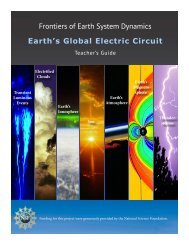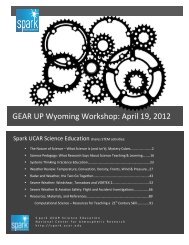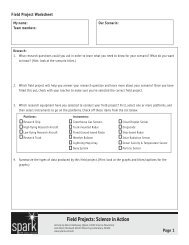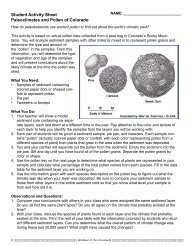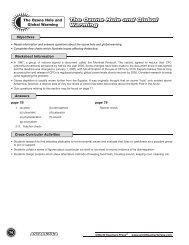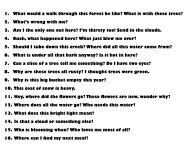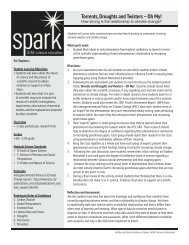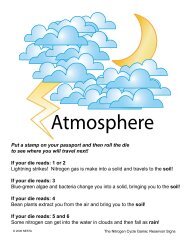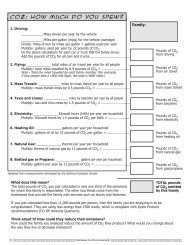#18- Air Pollution 101 Lesson Plan - Salsa!
#18- Air Pollution 101 Lesson Plan - Salsa!
#18- Air Pollution 101 Lesson Plan - Salsa!
You also want an ePaper? Increase the reach of your titles
YUMPU automatically turns print PDFs into web optimized ePapers that Google loves.
• Volatile Organic Compound: Any toxic carbon-based (organic) substance that easily<br />
become vapors or gases–e.g., solvents–paint thinners, lacquer thinner, degreasers, dry<br />
cleaning fluids 10<br />
Background Information:<br />
<strong>Air</strong> pollution can have detrimental impacts on humans, animals, plants, and water. For the<br />
most part, air pollution is caused by humans and derives from burning coal, oil, wood, and<br />
other carbon-based fuels to run factories, cars, and to generate electricity. <strong>Pollution</strong> is a<br />
major contributor to the development of acid rain and smog, as well, as global warming. In<br />
1970, the U.S. Environmental Protection Agency (EPA) was established through the<br />
original Clean <strong>Air</strong> Act to oversee pollution in the U.S. The agency was made responsible for<br />
overlooking dangerous emissions and analyzing the causes and effects. The EPA monitors<br />
the six “criteria pollutants;” particulate matter, carbon monoxide, ground-level ozone,<br />
sulfur dioxide, nitrous oxides, and lead to ensure that only safe concentrations are<br />
released into the atmosphere, thereby . The EPA also supports and enforces efforts to<br />
reduce pollution levels. Yet there are still many areas in the United States that do not meet<br />
EPA designated NAAQS.<br />
VOCs are not one of the 6 criteria pollutants the EPA is charged with regulating. However<br />
the EPA still monitors VOC’s and its effect and because VOCs react in the atmosphere to<br />
produce ozone, the EPA can regulate their use in common products used outdoors.<br />
However, The Clean <strong>Air</strong> Act gives the EPA no authority to regulate indoor air quality.<br />
VOCs contribute to ozone pollution outside and in high concentrations can be very<br />
dangerous to human health.<br />
Unlike the EPA, air pollution is not tied down. It travels through the air to different regions,<br />
states, and sometimes even other countries. <strong>Pollution</strong> not only degrades the environment but<br />
causes significant health problems for the human population. It’s therefore important for<br />
students to understand what’s in the air we breathe, where it comes from and what can be<br />
done to reduce the impact.<br />
Resources:<br />
• <strong>Air</strong> Pollutants Environmental Protection Agency<br />
http://www.epa.gov/air/airpollutants.html<br />
Thorough information about a wide range of air pollutants, including basic<br />
information, standards, and indoor air quality information.<br />
• 50 Things You Can Do California Environmental Protection Agency<br />
http://www.arb.ca.gov/html/brochure/50things.htm<br />
Detailed list of many things an individual can do to reduce air pollution<br />
• National Ambient <strong>Air</strong> Quality Standards (NAAQS) Environmental Protection Agency<br />
http://www.epa.gov/air/criteria.html<br />
Current NAAQS for the 6 air pollutants currently regulated by the EPA<br />
• Indoor & Outdoor <strong>Air</strong> <strong>Pollution</strong> Lawrence Berkeley National Laboratory<br />
10 McGraw-Hill Concise Dictionary of Modern Medicine, 2002 by The McGraw-Hill Companies, Inc.<br />
Retrieved 05 May 2011 from http://medical-dictionary.thefreedictionary.com/Volatile+organic+compounds.




